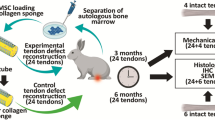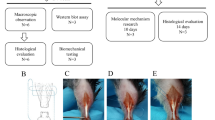Abstract
The aim of this study was to explore the potential for a better recovery outcome for the Achilles tendon at an early healing stage when a mixed biomaterial-tenocyte injection is used. The experimental animals underwent single limb Achilles tendon transection followed by suturing repair. A solution of either hyaluronic acid with or without tenocytes or normal saline was randomly chosen to be injected around the injury site after surgery. To obtain the comprehensive recovery condition of the rats on different management protocols, the animals were evaluated histologically, mechanically, and functionally. A significant difference in the recovery condition was found in the injured tendon injected with the hyaluronic acid solution with tenocytes compared with the other groups. Tendon stiffness and the locomotion abilities of the rats with healing Achilles tendons were improved in the hyaluronic acid with tenocyte transplantation group. The acceleration of the inflammatory phase in rats with the hyaluronic acid with tenocyte injections might be the major reason for the better functional outcomes.









Similar content being viewed by others

References
Soldatis JJ, Goodfellow DB, Wilber JH. End-to-end operative repair of Achilles tendon rupture. Am J Sports Med. 1997;25:90–5.
Ahmed Z, Underwood S, Brown RA. Low concentrations of fibrinogen increase cell migration speed on fibronectin/fibrinogen composite cables. Cell Motil Cytoskeleton. 2000;46:6–16.
O’Brien M. Functional anatomy and physiology of tendons. Clin Sports Med. 1992;11:505–20.
Hess GP, Cappiello WL, Poole RM, Hunter SC. Prevention and treatment of overuse tendon injuries. Sports Med. 1989;8:371–84.
Kirkendall DT, Garrett WE. Function and biomechanics of tendons. Scand J Med Sci Sports. 1997;7:62–6.
Sharma P, Maffulli N. Tendon injury and tendinopathy: healing and repair. J Bone Joint Surg Am. 2005;87:187–202.
O’Brien M. Structure and metabolism of tendons. Scand J Med Sci Sports. 1997;7:55–61.
Williams JG. Achilles tendon lesions in sport. Sports Med. 1986;3:114–35.
Chen J, Yu Q, Wu B, Lin Z, Pavlos NJ, Xu J, Ouyang H, Wang A, Zheng MH. Autologous tenocyte therapy for experimental Achilles tendinopathy in a rabbit model. Tissue Eng Part A. 2011;17:2037–48.
Chen JM, Willers C, Xu J, Wang A, Zheng MH. Autologous tenocyte therapy using porcine-derived bioscaffolds for massive rotator cuff defect in rabbits. Tissue Eng. 2007;13:1479–91.
Clarke AW, Alyas F, Morris T, Robertson CJ, Bell J, Connell DA. Skin-derived tenocyte-like cells for the treatment of patellar tendinopathy. Am J Sports Med. 2011;39:614–23.
Stoll C, John T, Conrad C, Lohan A, Hondke S, Ertel W, Kaps C, Endres M, Sittinger M, Ringe J, Schulze-Tanzil G. Healing parameters in a rabbit partial tendon defect following tenocyte/biomaterial implantation. Biomaterials. 2011;32:4806–15.
Chong AKS, Ang AD, Goh JCH, Hui JHP, Lim AYT, Lee EH, Lim BH. Bone marrow-derived mesenchymal stem cells influence early tendon-healing in a rabbit Achilles tendon model. J Bone Joint Surg Am. 2007;89A:74–81.
Awad HA, Butler DL, Boivin GP, Smith FN, Malaviya P, Huibregtse B, Caplan AI. Autologous mesenchymal stem cell-mediated repair of tendon. Tissue Eng. 1999;5:267–77.
Juncosa-Melvin N, Boivin GP, Gooch C, Galloway MT, West JR, Dunn MG, Butler DL. The effect of autologous mesenchymal stem cells on the biomechanics and histology of gel-collagen sponge constructs used for rabbit patellar tendon repair. Tissue Eng. 2006;12:369–79.
Noble PW. Hyaluronan and its catabolic products in tissue injury and repair. Matrix Biol. 2002;21:25–9.
Zimmerman E, Geiger B, Addadi L. Initial stages of cell-matrix adhesion can be mediated and modulated by cell-surface hyaluronan. Biophys J. 2002;82:1848–57.
Funakoshi T, Majima T, Iwasaki N, Suenaga N, Sawaguchi N, Shimode K, Minami A, Harada K, Nishimura S. Application of tissue engineering techniques for rotator cuff regeneration using a chitosan-based hyaluronan hybrid fiber scaffold. Am J Sports Med. 2005;33:1193–201.
Kutty JK, Cho E, Lee JS, Vyavahare NR, Webb K. The effect of hyaluronic acid incorporation on fibroblast spreading and proliferation within PEG-diacrylate based semi-interpenetrating networks. Biomaterials. 2007;28:4928–38.
Liang JI, Chen MY, Hsieh TH, Liu CY, Lam CF, Chen JJ, Yeh ML. Video-based Gait Analysis for Functional Evaluation of Healing Achilles Tendon in Rats. Ann Biomed Eng. 2012;40:2532–40.
Liu W, Chen B, Deng D, Xu F, Cui L, Cao Y. Repair of tendon defect with dermal fibroblast engineered tendon in a porcine model. Tissue Eng. 2006;12:775–88.
Lee HY, Hsieh TH, Liang JI, Yeh ML, Chen JJ. Quantitative video-based gait pattern analysis for hemiparkinsonian rats. Med Biol Eng Comput. 2012;50:937–46.
Robinson RO, Herzog W, Nigg BM. Use of Force Platform Variables to Quantify the Effects of Chiropractic Manipulation on Gait Symmetry. J Manipulative Physiol Ther. 1987;10:172–6.
Gouwanda D, Senanayake SMNA. Identifying gait asymmetry using gyroscopes-A cross-correlation and normalized symmetry index approach. J Biomech. 2011;44:972–8.
Murrell GA, Lilly EG, Davies H, Best TM, Goldner RD, Seaber AV. The Achilles functional index. J Orthop Res. 1992;10:398–404.
Liang JI, Chen MY, Hsieh TH, Liu CY, Lam CF, Chen JJ, Yeh ML. Video-based gait analysis for functional evaluation of healing Achilles tendon in rats. Ann Biomed Eng. 2012;40(12):2532–40.
Li R, Nauth A, Li C, Qamirani E, Atesok K, Schemitsch EH. Expression of VEGF gene isoforms in a rat segmental bone defect model treated with EPCs. J Orthop Trauma. 2012;26:689–92.
Yuan J, Murrell GA, Wei AQ, Wang MX. Apoptosis in rotator cuff tendonopathy. J Orthop Res. 2002;20:1372–9.
Machner A, Baier A, Wille A, Drynda S, Pap G, Drynda A, Mawrin C, Buhling F, Gay S, Neumann W, Pap T. Higher susceptibility to Fas ligand induced apoptosis and altered modulation of cell death by tumor necrosis factor-alpha in periarticular tenocytes from patients with knee joint osteoarthritis. Arthritis Res Ther. 2003;5:R253–61.
Oshiro W, Lou J, Xing X, Tu Y, Manske PR. Flexor tendon healing in the rat: a histologic and gene expression study. J Hand Surg Am. 2003;28:814–23.
Yeung CK, Guo X, Ng YF. Pulsed ultrasound treatment accelerates the repair of Achilles tendon rupture in rats. J Orthop Res. 2006;24:193–201.
See EK, Ng GY, Ng CO, Fung DT. Running exercises improve the strength of a partially ruptured Achilles tendon. Br J Sports Med. 2004;38:597–600.
Krahe MA, Berlet GC. Achilles tendon ruptures, re rupture with revision surgery, tendinosis, and insertional disease. Foot Ankle Clin. 2009;14:247–75.
Clarke KA, Still J. Gait analysis in the mouse. Physiol Behav. 1999;66:723–9.
Author information
Authors and Affiliations
Corresponding author
Rights and permissions
About this article
Cite this article
Liang, JI., Lin, PC., Chen, MY. et al. The effect of tenocyte/hyaluronic acid therapy on the early recovery of healing Achilles tendon in rats. J Mater Sci: Mater Med 25, 217–227 (2014). https://doi.org/10.1007/s10856-013-5036-9
Received:
Accepted:
Published:
Issue Date:
DOI: https://doi.org/10.1007/s10856-013-5036-9



